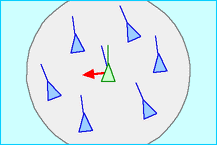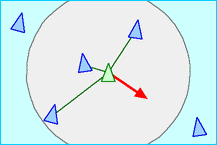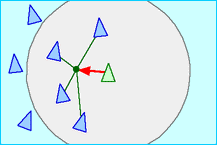A simulation of flocking behaviours in nature
This project is a work-in-progress implementation of a flocking simulation of agents using Java and Processing. The goal of this project is to explore and experiment with different flocking behaviors and to create visually interesting and dynamic simulations.
The project currently includes collision detection with both Euclidean distance measurements and with a quadtree data structure that I implemented, As well as the additon of obstacles for the vehicles to avoid. As a work-in-progress project, there may be bugs and incomplete features, but I welcome feedback and contributions from others interested in exploring flocking
simulations.
For a full demo video check this link.
Flocking behavior is a phenomenon observed in nature where groups of animals move in a coordinated way without a centralized control. Examples include flocks of birds, schools of fish, and swarms of locusts. Flocking behavior has been studied in various scientific fields, including biology, physics, and computer science, as it represents a complex system that emerges from the interactions between individual agents. By understanding the underlying principles of flocking behavior, we can apply this knowledge to various fields, such as robotics, animation, and game development.
The following implementation is based on the flocking behavior and boid simulation characteristics presented by Craig Reynolds.
The three core principles of flocking behavior are alignment, separation, and cohesion, which were implemented in this project.
Alignment
- Alignment - steer towards the average heading of local flockmates - refers to the tendency of an individual agent to align its velocity with the average velocity of its neighboring agents. This principle allows for a coordinated movement of the flock towards a common direction, creating a sense of unity and common purpose.
Separation
- Separation - "steer to avoid crowding local flockmates" - refers to the tendency of an individual agent to maintain a minimum distance from its neighboring agents. This principle helps to prevent collisions between agents and maintain a sense of personal space. By avoiding collisions, agents can move freely within the flock, which contributes to the overall fluidity of the flocking behavior.
Cohesion
- Cohesion - steer to move toward the average position of local flockmates - refers to the tendency of an individual agent to move towards the center of mass of its neighboring agents. This principle creates a sense of togetherness and group cohesion within the flock. By moving towards the center of mass, agents can maintain a consistent distance from their neighbors and avoid becoming isolated from the flock.
By implementing these principles, this project simulates the emergent behavior of a flock, which creates visually interesting and dynamic simulations. This project allows for experimentation with different parameters to explore the different behaviors that can arise from these principles. Additionally, the quadtree data structure implemented in this project allows for efficient collision detection, which improves performance for large numbers of agents.
The program requires the following to run:
- Java 8
- Processing Core
I highly recommend downloading and using the processing native IDE here
Clone the repo:
git clone https://github.com/avihuxp/FlockingSimulation.git To add an obstacle to the screen for the vehicles to avoid, simply left click where you would like to place it, and to remove an obstacle, right click on it.
There are many parameters one can toy with, the main ones are:
BoidSimulation.NUM_OF_VEHICLES- Sets the number of elements in the simulation.BoidSimulation.NUM_OF_FLOCKS- Sets the number of flocks in the simulation. Each flock has its own color, and does not preform alignment and cohesion with other flocks.BoidSimulation.WITH_QUAD- Set to true to use QuadTree for collision detection.
- Add obstacles to the simulation
- Implement spatial hashing to improve runtime performance
- Add UI for parameter tweaking
- Add predators to the simulation
- Add visual aids for better understanding of the flocking behavior
See the open issues
for a full list of proposed features (and known issues).
This project is heavily inspired and implemented with the help of the following sources:
- The aforementioned "Boids" article by Craig Reynolds
- The Coding Train's video on Flocking Simulation, which is when I first became familiar with this subject.
MIT License
Copyright (c) 2023 avihuxp
Permission is hereby granted, free of charge, to any person obtaining a copy of this software and associated documentation files (the "Software"), to deal in the Software without restriction, including without limitation the rights to use, copy, modify, merge, publish, distribute, sublicense, and/or sell copies of the Software, and to permit persons to whom the Software is furnished to do so.
The above copyright notice and this permission notice shall be included in all copies or substantial portions of the Software.










